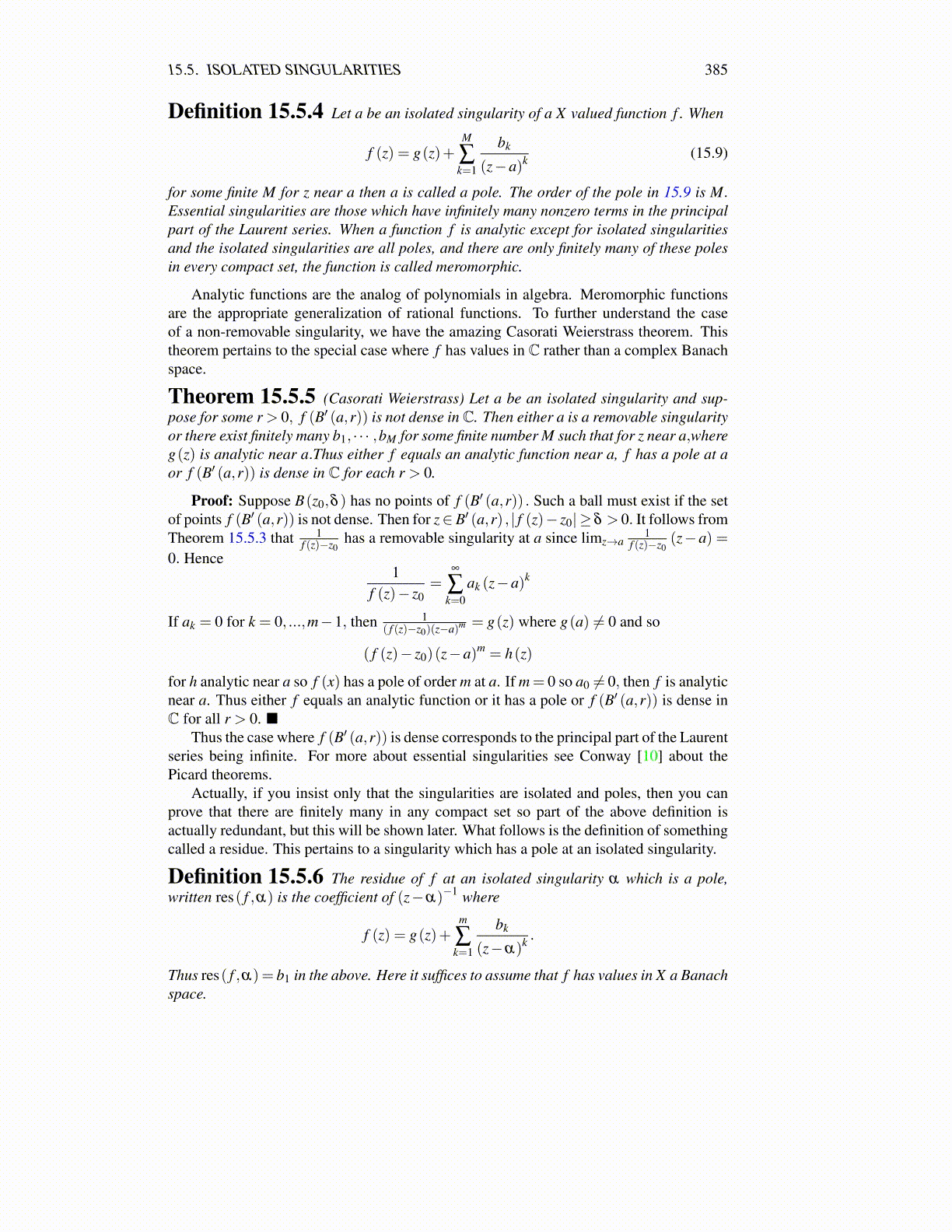
15.5. ISOLATED SINGULARITIES 385
Definition 15.5.4 Let a be an isolated singularity of a X valued function f . When
f (z) = g(z)+M
∑k=1
bk
(z−a)k (15.9)
for some finite M for z near a then a is called a pole. The order of the pole in 15.9 is M.Essential singularities are those which have infinitely many nonzero terms in the principalpart of the Laurent series. When a function f is analytic except for isolated singularitiesand the isolated singularities are all poles, and there are only finitely many of these polesin every compact set, the function is called meromorphic.
Analytic functions are the analog of polynomials in algebra. Meromorphic functionsare the appropriate generalization of rational functions. To further understand the caseof a non-removable singularity, we have the amazing Casorati Weierstrass theorem. Thistheorem pertains to the special case where f has values in C rather than a complex Banachspace.
Theorem 15.5.5 (Casorati Weierstrass) Let a be an isolated singularity and sup-pose for some r > 0, f (B′ (a,r)) is not dense in C. Then either a is a removable singularityor there exist finitely many b1, · · · ,bM for some finite number M such that for z near a,whereg(z) is analytic near a.Thus either f equals an analytic function near a, f has a pole at aor f (B′ (a,r)) is dense in C for each r > 0.
Proof: Suppose B(z0,δ ) has no points of f (B′ (a,r)) . Such a ball must exist if the setof points f (B′ (a,r)) is not dense. Then for z∈ B′ (a,r) , | f (z)− z0| ≥ δ > 0. It follows fromTheorem 15.5.3 that 1
f (z)−z0has a removable singularity at a since limz→a
1f (z)−z0
(z−a) =0. Hence
1f (z)− z0
=∞
∑k=0
ak (z−a)k
If ak = 0 for k = 0, ...,m−1, then 1( f (z)−z0)(z−a)m = g(z) where g(a) ̸= 0 and so
( f (z)− z0)(z−a)m = h(z)
for h analytic near a so f (x) has a pole of order m at a. If m= 0 so a0 ̸= 0, then f is analyticnear a. Thus either f equals an analytic function or it has a pole or f (B′ (a,r)) is dense inC for all r > 0. ■
Thus the case where f (B′ (a,r)) is dense corresponds to the principal part of the Laurentseries being infinite. For more about essential singularities see Conway [10] about thePicard theorems.
Actually, if you insist only that the singularities are isolated and poles, then you canprove that there are finitely many in any compact set so part of the above definition isactually redundant, but this will be shown later. What follows is the definition of somethingcalled a residue. This pertains to a singularity which has a pole at an isolated singularity.
Definition 15.5.6 The residue of f at an isolated singularity α which is a pole,written res( f ,α) is the coefficient of (z−α)−1 where
f (z) = g(z)+m
∑k=1
bk
(z−α)k .
Thus res( f ,α) = b1 in the above. Here it suffices to assume that f has values in X a Banachspace.